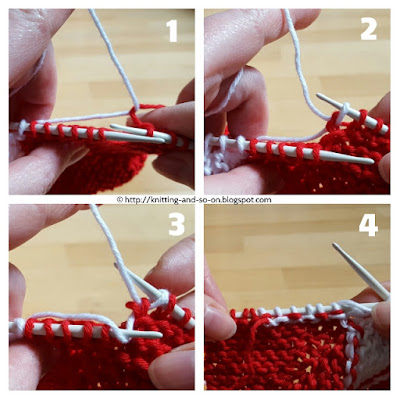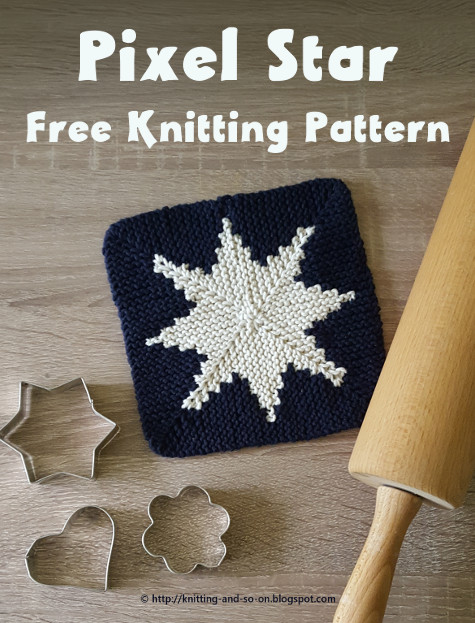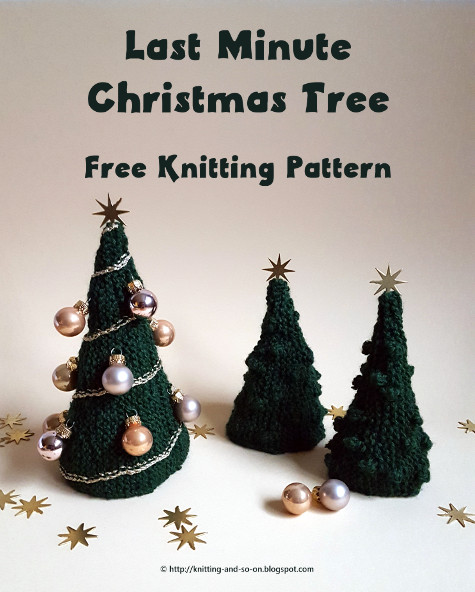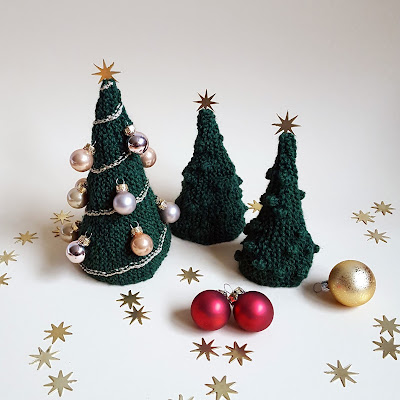I love baking for christmas. Apart from the result - sweet cookies - there is also the experience of making them with your own hands and it makes your home smell lovely. This experience can even be more fun, if you have a bit of christmas themed equipment - like these lovely potholders with a christmas tree motif.
This potholder is knitted in a combination of short rows and intarsia. That way you don't have too many ends to weave in and the WS of the piece looks presentable
As to the name, Tannenbäumchen is the german word for a small christmas tree - or fir tree to be exact.

This work by
Knitting and so on is licensed under a
Creative Commons Attribution-NonCommercial-ShareAlike 4.0 International License.
 Materials
Materials
- a total of about 30 grams of DK weight cotton yarn - about 10 grams of C2 (color of Xmas tree) and 20 grams of C1 (background color)
- 3.5 mm needles - if you use yarn of a different weight, use a needle that is one size below the size that the yarn calls for
- scrap yarn for provisional CO
- a tapestry needle for grafting and to weave in ends
Techniques & Notation

- Throughout the pattern, the following notation is used: C1 (k4), C2 (k10, w+t, k10), C1 (k to end) means, knit 4 stitches in C1, change to C2 and knit 10 sts, do a wrap and turn, knit 10 stitches and then change back to C1 and k to end. I.e. color is indicated before the knitting instructions for that yarn and the knitting instructions for that yarn are given in brackets after the color.
- Short rows with wrap and turn (w+t) - as shown in this YouTube video by Very Pink Knits.
Even though this potholder is knit in garter stitch, I picked up the wraps, i.e. two wraps that are on top of each other. Here's a YouTube video that shows how to pick up your wraps (also by Very Pink Knits).
- Note: in some rows the wrap has to be made just at the color change in the row below, e.g. Ridge B11 where you knit 11 sts in C1 and the 12 stitch that is to be wrapped was knitted in C2. In this case, it's advisable to change the color (as if to knit the next stitch in the new color), wrap and turn in the new color, and then to change back. This gives nicer color edges.
- Provisional CO: My favorite method for a provisional CO is the crochet provisional CO - it is shown in this Youtube video by New Stitch a Day.
- Grafting in Garter Stitch: A technique to get an invisible (knitted) seam - this technique is shown in this YouTube Video by knittinghelp.com.
- Weaving in (ends) while knitting: as shown in this YouTube video by So, I make stuff. This technique is used here to carry yarn of another color to point further along in your row while avoiding a long float.
- Weaving in yarn while carrying it back: Draw a long loop of C2 (white in the illustration) to the point closer to the beginning of the rowwhere you want to knit it (picture 1). This gives you a really long float. Knit the first stitch (picture 2). Before knitting the second stitch, catch the float by put the left hand needle under the float (picutre 3) and then knit the stitch with your working yarn as usual. If you catch the float every second stitch, the WS will look as shown in picture 4. (This is a bit like catching floats in stranded knitting as shown in this YouTube video by Knit Purl Hunter.)
The last two techniques (this and weaving in (ends) while knitting) will are used to avoid a long float that runs parallel to your knitting - and to avoid cutting your yarn.
 |
| Click to enlarge |
Construction
This potholder is knitted in 5 parts. It starts with a provisional CO. Then each row is a stitch shorter than the last one, One part ends, when the row is only 1 stitch (plus 1 w+t) long - then the next part begins and each row is one stitch longer than the last one until all stitches are knitted and we've sucessfully knitted around a corner. Then the row length is getting shorter again for the next corner.
After knitting around four corners and the two sides (CO and last row) are grafted in garter stitch.
Size
With DK yarn, the piece measures about 17 cm x 17 cm.
Instructions
With scrap yarn provisionally CO 17 stitches
Part A:
Setup row A0 (WS): C2 (k12), C1 (k5)
Ridge A1: C1 (k6), C2 (k10, w+t, k10), C1 (k6)
Ridge A2: C1 (k7), C2 (k8, w+t, k8), C1 (k7)
Ridge A3: C1 (k8), C2 (k6, w+t, k6), C1 (k8)
Ridge A4: C1 (k9), C2 (k4, w+t, k4), C1 (k9)
Ridge A5: C1 (k10), C2 (k2, w+t, k2), C1 (k10)
Ridge A6: C1 (k11), C2 (w+t), C1 (k10)
Ridge A7: C1 (k10, w+t, k10)
Ridge A8: C1 (k9, w+t, k9)
Ridge A9: C1 (k8, w+t, k8)
Ridge A10: C1 (k7, w+t, k7)
Ridge A11: C1 (k6, w+t, k6)
Ridge A12: C1 (k5, w+t, k5)
Ridge A13: C1 (k4, w+t, k4)
Ridge A14: C1 (k3, w+t, k3)
Ridge A15: C1 (k2, w+t, k2)
Ridge A16: C1 (k1, w+t, k1)
Part B:
Ridge B1: C1 (k1, w+t, k1)
Ridge B2: C1 (k2, w+t, k2)
Ridge B3: C1 (k3, w+t, k3)
Ridge B4: C1 (k4, w+t, k4)
Ridge B5: C1 (k5, w+t, k5)
Ridge B6: C1 (k6, w+t, k6)
Ridge B7: C1 (k7, w+t, k7)
Ridge B8: C1 (k8, w+t, k8)
Ridge B9: C1 (k9, w+t, k9)
Ridge B10: C1 (k10, w+t, k10)
Ridge B11: C1 (k11), C2 (w+t), C1(k11)
Ridge B12: C1 (k11), C2 (k1, w+t, k1), C1 (k11)
Ridge B13: C1 (k10), C2 (k3, w+t, k3), C1 (k11)
Ridge B14: C1 (k14 - over the last 4 sts carry C2 back and weave it in), C2 (w+t), C1 (k14)
Ridge B15: C1 (k13), C2 (k2, w+t, k2), C1 (k13)
Ridge B16: C1 (k12), C2 (k4, w+t, k4), C1 (k12)
Ridge B17: C1 (k11), C2 (k6, w+t, k6), C1 (k11)
Ridge B18: C1 (k10), C2 (k6, w+t, k6), C1 (k10)
Ridge B19: C1 (k9), C2 (k6, w+t, k6), C1 (k9)
Ridge B20: C1 (k8), C2 (k6, w+t, k6), C1 (k8)
Ridge B21: C1 (k7), C2 (k6, w+t, k6), C1 (k7)
Ridge B22: C1 (k11 - over the last 4 sts carry C2 back and weave it in), C2 (k1, w+t, k1), C1 (k11)
Ridge B23: C1 (k10), C2 (k1, w+t, k1), C1 (k10)
Ridge B24: C1 (k9), C2 (k1, w+t, k1), C1 (k9)
Ridge B25: C1 (k8), C2 (k1, w+t, k1), C1 (k8)
Ridge B26: C1 (k7), C2 (k1, w+t, k1), C1 (k7)
Ridge B27: C1 (k6), C2 (k1, w+t, k1), C1 (k6)
Ridge B28: C1 (k5), C2 (k1, w+t, k1), C1 (k5)
Ridge B29: C1 (k4), C2 (k1, w+t, k1), C1 (k4)
Ridge B30: C1 (k4), C2 (w+t), C1 (k4)
Ridge B31: C1 (k3, w+t, k3)
Ridge B32: C1 (k2, w+t, k2)
Ridge B33: C1 (k1, w+t, k1)
Part C:
Ridge C1: C1 (k1, w+t, k1)
Ridge C2: C1 (k2, w+t, k2)
Ridge C3: C1 (k3, w+t, k3)
Ridge C4: C1 (k4), C2 (w+t), C1 (k4)
Ridge C5: C1 (k4), C2 (k1, w+t, k1), C1 (k4)
Ridge C6: C1 (k4), C2 (k2, w+t, k2), C1 (k4)
Ridge C7: C1 (k4), C2 (k3, w+t, k3), C1 (k4)
Ridge C8: C1 (k4), C2 (k4, w+t, k4), C1 (k4)
Ridge C9: C1 (k4), C2 (k5, w+t, k5), C1 (k4)
Ridge C10: C1 (k4), C2 (k6, w+t, k6), C1 (k4)
Ridge C11: C1 (k4), C2 (k7, w+t, k7), C1 (k4)
Ridge C12: C1 (k4), C2 (k8, w+t, k8), C1 (k4)
Ridge C13: C1 (k4), C2 (k9, w+t, k9), C1 (k4)
Ridge C14: C1 (k4), C2 (k10, w+t, k10), C1 (k4)
Ridge C15: C1 (k4), C2 (k11, w+t, k11), C1 (k4)
Ridge C16: C1 (k4), C2 (k12, w+t, k12), C1 (k4)
Ridge C17: C1 (k4), C2 (k13, w+t, k13), C1 (k4)
The middle of ridge C17 is also the middle of the potholder. From this point on, you have to knit the same rows in reverse order
Ridge C18 = Ridge C16
Ridge C19 = Ridge C15
Ridge C20 = Ridge C14
Ridge C21 = Ridge C13
...
Ridge C32 = Ridge C2
Ridge C33 = Ridge C1
Part D: Part B in reverse order
Ridge D1 = Ridge B33
Ridge D2 = Ridge B32
Ridge D3 = Ridge B31
...
D12 = B22, but carry the C2 yarn backwards and weave it in
...
D24 = B14, but carry the C2 yarn backwards and weave it in
...
Ridge D32 = Ridge B2
Ridge D33 = Ridge B1
Part E: Part A in reverse order
Ridge E1 = Ridge A16
Ridge E2 = Ridge A15
...
Ridge E15 = Ridge A2
Ridge E16 = Ridge A1
Take out your scrap yarn of the provisional cast on and put the live stitches on a knitting needle. Cut your yarns but leave tails long enough for grafting.
Graft in garter stitch: 5 sts in C1 and 12 sts in C2.
After grafting there is still a small hole in the middle of the piece - you can sew this closed with your C2 yarn tail. Sew in ends afterwards.
Chart
The chart below shows one half of the potholder. The numbers indicate the number of stitches per color of each ridge. The green number gives the stitches in C2 and the black number the stitches in C1.













































